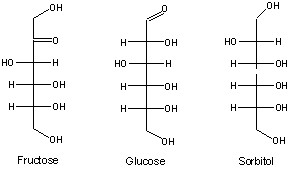Sugar Fuels
General Information
Rocket propellants prepared from KNO3 and sugar are relatively simple to prepare and are some of the safest propellants to formulate. A traditional sugar propellant formulation is typically prepared in a 65:35 oxidizer to fuel ratio. This ratio is somewhat fuel rich. This ratio allows, among other things, for the formulation to be more fluid in its molten state. There are quite a number of sugars that one can choose from to prepare a “candy” propellant. These sugars range greatly in melting point, crystallinity, thermal stability, and burn rate performance. However, when used as the fuel in a propellant they all deliver roughly the same specific impulse (ISP) in spite of their different physical properties. At motor chamber pressures of ~1000 psi a typical ISP is found to be in the low 130 second range. This performance range places a sugar propellant roughly in between that of black powder and ammonium perchlorate composite propellants (APCP).
Sugars are part of the carbohydrate family. All carbohydrates have one thing in common. For each carbon in the carbohydrate molecule you will find at least one oxygen attached to it. The oxygen containing group most often attached to a carbon is an alcohol group. Several simple sugars are depicted below.
Each of these three sugars contain 6 carbon atoms. Each has one oxygen atom attached to their carbons. Two of them, fructose and glucose have one carbon with a double bonded oxygen atom. Sugars with double bonded oxygen are less thermally stable and tend to caramelize when overheated. Those that only have alcohol groups like sorbitol, are much less prone to this decomposition. Natural monosaccarides can contain from 3 to 7 carbons. They can also exist as multiple sugars linked together. Sucrose is a sugar dimer or disaccharide. Many carbohydrates exist in long chains of sugar molecules. Most common among these are cellulose and starch. There are many other molecules that fall into the carbohydrate family that many do not consider sugars. Among these are glycerin, lactic acid, tartaric acid, citric acid, and even ethylene glycol.
Many sugar motor makers like to use the most available sugar, sucrose. It is very inexpensive and when used together with corn syrup can be relativly easy to prepare and cast. Jimmy Yawn has an excellent web page on this type of propellant http://www.jamesyawn.net/ .
My favorite sugars for use as fuels in propellants are sorbitol, mannitol, and isomaltitol. These sugars have proven easier to work with than sucrose and function very well in some low melting eutectic propellant mixtures. They are more expensive than sucrose but are still less expensive by far than AP type propellants.
More details on the physical properties of different sugars and their propellant properties can be found by following the links on this page.
General Information
Rocket propellants prepared from KNO3 and sugar are relatively simple to prepare and are some of the safest propellants to formulate. A traditional sugar propellant formulation is typically prepared in a 65:35 oxidizer to fuel ratio. This ratio is somewhat fuel rich. This ratio allows, among other things, for the formulation to be more fluid in its molten state. There are quite a number of sugars that one can choose from to prepare a “candy” propellant. These sugars range greatly in melting point, crystallinity, thermal stability, and burn rate performance. However, when used as the fuel in a propellant they all deliver roughly the same specific impulse (ISP) in spite of their different physical properties. At motor chamber pressures of ~1000 psi a typical ISP is found to be in the low 130 second range. This performance range places a sugar propellant roughly in between that of black powder and ammonium perchlorate composite propellants (APCP).
Sugars are part of the carbohydrate family. All carbohydrates have one thing in common. For each carbon in the carbohydrate molecule you will find at least one oxygen attached to it. The oxygen containing group most often attached to a carbon is an alcohol group. Several simple sugars are depicted below.
Each of these three sugars contain 6 carbon atoms. Each has one oxygen atom attached to their carbons. Two of them, fructose and glucose have one carbon with a double bonded oxygen atom. Sugars with double bonded oxygen are less thermally stable and tend to caramelize when overheated. Those that only have alcohol groups like sorbitol, are much less prone to this decomposition. Natural monosaccarides can contain from 3 to 7 carbons. They can also exist as multiple sugars linked together. Sucrose is a sugar dimer or disaccharide. Many carbohydrates exist in long chains of sugar molecules. Most common among these are cellulose and starch. There are many other molecules that fall into the carbohydrate family that many do not consider sugars. Among these are glycerin, lactic acid, tartaric acid, citric acid, and even ethylene glycol.
Many sugar motor makers like to use the most available sugar, sucrose. It is very inexpensive and when used together with corn syrup can be relativly easy to prepare and cast. Jimmy Yawn has an excellent web page on this type of propellant http://www.jamesyawn.net/ .
My favorite sugars for use as fuels in propellants are sorbitol, mannitol, and isomaltitol. These sugars have proven easier to work with than sucrose and function very well in some low melting eutectic propellant mixtures. They are more expensive than sucrose but are still less expensive by far than AP type propellants.
More details on the physical properties of different sugars and their propellant properties can be found by following the links on this page.








